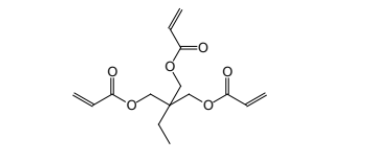Enhanced TDS
Identification & Functionality
- Blend
- No
- CASE Ingredients Functions
- Chemical Family
- Chemical Name
- Country of Origin
- Product Code
- MITM00578
- Single Ingredient
- Yes
- Synonyms
- 2-Ethyl-2-(hydroxymethyl)-1,3-propanediol triacrylate, TMPTA
- Technologies
- Product Families
- Chemical Structure

Features & Benefits
- CASE Ingredients Features
- Labeling Claims
- Product Benefits
TMPTA is characterized by:
• Low viscosity
• Low color
UV/EB curable formulated products containing TMPTA are characterized by:
• High cross-link density
• Rapid cure response
• High gloss
• Excellent hardness
• Good chemical resistance
Applications & Uses
- Applicable Processes
- Coating End Applications
- Compatible Polymers & Resins
- Cure Method
- Ink & Toner End Applications
- Markets
- Applications
- Product Applications
- TMPTA is a cost effective diluent compatible with the wide range of acrylated resins used in radiation curing applications.
- Its ability to enhance reactivity, hardness, gloss, and chemical and wear resistance properties makes TMPTA popular for overprint varnishes, inks, coatings, traffic striping paints and rubber crosslinking.
Properties
- Physical Form
Packaging & Availability
- Packaging Type
Principal Information
- Group Principal Number
- S000001
- Principal
Storage & Handling
- Storage Conditions
- Care should be taken not to expose the product to high temperature conditions, direct sunlight, ignition sources, oxidizing agents, alkalis or acids.
- This might cause uncontrollable polymerization of the product with the generation of heat.
- Storage and handling should be in stainless steel, amber glass, amber polyethylene or baked phenolic lined containers.
- Procedures that remove or displace oxygen from the material should be avoided.
- Do not store this material under an oxygen free atmosphere.
- Dry air is recommended to displace material removed from the container.
- Wash thoroughly after handling.
- Keep container tightly closed.
- Use with adequate ventilation.
Other
- Appearance
- Clear liquid
- Appearance (SDS)
- Liquid
- Color (SDS)
- Clear colorless to pale yellow
- Flammability (SDS)
- Normal combustion
- IATA/ICAO Proper Shipping Name
- Environmentally hazardous substance, liquid, N.O.S.
- IATA/ICAO Technical name (N.O.S.)
- Trimethylolpropane triacrylate
- IATA/ICAO UN Number
- UN3082
- IMO/IMDG Proper Shipping Name
- Environmentally hazardous substance, liquid, N.O.S.
- IMO/IMDG Technical name (N.O.S.)
- Trimethylolpropane triacrylate
- IMO/IMDG UN Number
- UN3082
- Item Number
- Odor (SDS)
- Ester acrylate
- Other Hazards
- Polymerization may occur from excessive heat, contamination or exposure to direct sunlight .
- Oxidizing Properties (SDS)
- Non oxidizing
- Protect from Freezing
- Yes
- TDG Canada Proper Shipping Name
- Environmentally hazardous substance, liquid, N.O.S.
- TDG Canada Technical name (N.O.S.)
- Trimethylolpropane triacrylate
- TDG Canada UN Number
- UN3082
- Temperature Control
- Yes
- USA/DOT Proper Shipping Name
- Environmentally hazardous substance, liquid, N.O.S.
- USA/DOT Technical name (N.O.S.)
- Trimethylolpropane triacrylate
- USA/DOT UN Number
- UN3082
- Material Composition
Value Units Test Method / Conditions Solvent Content max. 0.09 %(W/W) %(W/W) residue - Optical Properties
Value Units Test Method / Conditions Color Scale max. 50.0 Pt-Co Pt-Co - Physical Properties
Value Units Test Method / Conditions Density 1.1 g/mL g/mL at 25°C Flash Point min. 100.0 °C °C SetaFlash Closed Cup Storage Temperature 39.0-104.0 °F °F Viscosity 80.0-135.0 cPs cPs at 25°C - SDS Physical and Chemical Properties
Value Units Test Method / Conditions Boiling Point (SDS) min. 100.0 °C °C Kinematic Viscosity (SDS) 80.0-120.0 mPa.s mPa.s at 25°C Log Partition Coefficient (Log Pow) (SDS) 4.35 - at 20°C Solubility In Water (SDS) 500.0 mg/L mg/L at 20°C Specific Gravity (SDS) 1.11 - Vapor Pressure (SDS) max. 0.1 Pa Pa at 20°C Volatile Content (SDS) max. 0.3 %(W/W) %(W/W) - Shelf Life & Stability
Value Units Test Method / Conditions Shelf Life 730.0 d d
